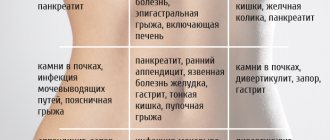Appendicitis is an inflammation of the appendix, a finger-shaped extension of the cecum that is located in the lower right side of the abdomen. With appendicitis, pain occurs in the lower right corner of the abdomen. However, for most people, the pain starts around the belly button and then moves. As the inflammation progresses, the pain tends to get worse and eventually become intense. The localization of pain with appendicitis may be different depending on the age and gender of the patient. This is especially common in children and pregnant women.
The standard treatment for appendicitis is surgical removal of the inflamed appendix - appendectomy
.
What is an appendectomy?
Appendectomy is a surgical operation to remove the appendix.
The appendix is a vermiform appendage that is an appendage of the cecum. It is believed that the appendix stimulates the immune system and improves the body's defense resources. The appendix is a cylindrical organ, hollow inside and without a through passage. The average length of the appendix is 8–10 cm. Appendicitis is a disease associated with inflammation of the appendix. It can occur in acute or chronic form. In chronic appendicitis, appendectomy is performed routinely. An acute form of inflammation of the appendix requires timely surgical intervention.
Causes of appendicitis
Inflammation of the appendix is caused by opportunistic microorganisms. When examining the affected tissue of the inflamed appendix, Escherichia coli, enterococcus, streptococcus, Staphylococcus aureus and anaerobic microorganisms are most often found. Pathogenic microorganisms penetrate the wall of the appendix from its lumen.
Doctors identify factors that provoke inflammation of the appendix:
- inflammatory process in the intestines;
- deformation of the appendix, in which there is a violation of blood circulation in the walls of the organ, which leads to necrosis of the appendix tissue;
- blockage of the appendix - fecal stones, neoplasms, foreign bodies and accumulation of parasites can close the lumen of the appendix. At the site of the blockage, microbes begin to actively multiply, causing inflammation.
About common complications of appendicitis
Intestinal obstruction can cause appendicitis.
Acute appendicitis often occurs with complications. The most common problems that accompany inflammation of the appendix are listed below:
- Intestinal obstruction. As mentioned above, often the cause of appendicitis is blockage of the lumen between the appendix and the rest of the gastrointestinal tract. If the factors that provoked the disease were not immediately eliminated, the risk of a similar problem occurring in other parts of the intestine and, as a result, the development of obstruction is extremely high. This complication can be diagnosed by the accompanying symptoms - bloating, nausea and repeated vomiting.
- Inflammation of the portal vein. If appendicitis was caused by an infection, inflammatory processes can affect other organs of the gastrointestinal tract. Most often, the portal vein, which is involved in the blood supply to the liver, spleen, stomach and pancreas, as well as most of the intestines, suffers from purulent inflammation.
- Peritonitis (inflammation of the peritoneum). In the event of a rupture of the appendix, the pus accumulated in it spreads throughout the abdominal cavity, provoking the development of inflammatory processes of varying severity. It is peritonitis that causes most fatal cases of acute appendicitis and minimizes the patient’s chances of a full recovery.
Symptoms of appendicitis inflammation
Chronic appendicitis is a sluggish inflammation of the appendix of the cecum, as a result of which the walls of the organ are replaced by scar tissue and infiltrated by immunocompetent cells. Doctors distinguish three forms of chronic appendicitis:
- Recurrent form - characterized by alternating periods of exacerbation and remission with minor clinical manifestations (moderate pain in the right iliac region).
- Residual form (residual) - develops when, after an acute attack, inflammatory phenomena in the appendix are only partially relieved.
- Primary chronic form - develops without a primary acute attack, development occurs gradually.
As a rule, chronic inflammation of the appendix is accompanied by a dull aching, stabbing or pressing pain in the right iliac region. Pain, as a rule, intensifies with physical activity and poor diet.
Acute inflammation of the appendix begins with swelling of the organ, then it begins to fill with pus.
About the stages of disease development
Catarrhal appendicitis is the initial stage of the disease.
As a rule, acute appendicitis occurs quite rapidly, successively passing through several stages of its development:
- Catarrhal appendicitis. At the initial stage of the disease, the inflamed appendix increases slightly in size, which may be accompanied by pain in the abdominal area and periodic nausea.
- Purulent appendicitis. As the name suggests, at this stage of development of the disease, the walls and internal cavity of the appendix become covered with purulent foci. This process is accompanied by acute pain in the right side.
- Phlegmonous appendicitis. At this stage of the disease, the appendix is almost completely saturated with pus, due to which it significantly increases in size. Pain in the right side during this period becomes almost unbearable.
- Rupture of the appendix. The appendix bursts, and its contents spill throughout the abdominal cavity, causing the development of peritonitis and other complications.
Symptoms of acute appendicitis:
- severe abdominal pain, which may intensify with palpation;
- constipation or diarrhea;
- nausea, vomiting;
- loss of appetite;
- flatulence (bloating);
- temperature increase.
If such symptoms occur, it is important to seek medical help promptly. If the appendix is not removed in a timely manner, perforation (rupture) of the organ may occur, causing pus to enter the abdominal cavity and cause peritonitis, a complication that can be fatal.
If you are concerned about one or more of the above symptoms, contact your surgeon immediately for advice. You can make an appointment at a convenient time with a surgeon at Euromed Clinic by phone + or online.
Indications for appendectomy
Surgery to remove the appendix is used for chronic or acute forms of appendicitis. In addition, appendectomy is performed if there is an appendiceal infiltrate, as well as if neoplasms are detected in the appendix.
Emergency appendectomy is usually performed no later than one hour after diagnosis. In case of chronic appendicitis or appendicular infiltrate, surgery to remove appendicitis is performed as planned.
The main methods for removing appendicitis:
- Open appendectomy - performed through an 8-10 cm incision in the right iliac region. Through the resulting incision, the surgeon separates the appendix from the surrounding tissues and then removes the organ. Removal of appendicitis using this method is indicated when the infectious process has spread into the abdominal cavity or when the appendix is located incorrectly.
- Laparoscopic appendectomy is an endoscopic method that allows you to cut out the appendix through three small punctures in the abdominal wall. This type of operation to remove appendicitis is performed routinely for chronic and acute uncomplicated appendicitis. Laparoscopy for appendicitis is a minimally invasive procedure, since the operation causes minimal trauma to the anterior abdominal wall.
If pathological factors are identified (atypical location or presence of adhesions)
During the operation, it is possible that the surgeon may detect adhesions. They are often a consequence of previous surgical interventions. In addition, access to the abdominal cavity may reveal other pathologies of tissues or organs. Then the surgeon decides to eliminate the identified pathologies. Accordingly, the time allotted for the operation will increase exactly in proportion to the number of pathologies.
If the surgeon discovers an atypical location of appendicitis, then the time for surgical treatment will increase significantly. The complexity of this phenomenon lies in the fact that the atypical location is very difficult to diagnose, and therefore can only be detected during surgical procedures. An hour and a half is allotted to perform such an operation.
Reference!
An atypical location of the inflamed appendix is observed in almost 30% of patients.
There may be additional factors that influence the duration of surgical procedures. For example, the age of the person being operated on. If a child under three years of age is placed on the operating table, the operation will last at least two hours. This is explained by the fact that these babies have not yet fully formed their immune system, so the possibility of complications cannot be ruled out.
Video - What are the complications of appendicitis?
Contraindications for laparoscopic appendectomy:
- late stages of pregnancy;
- severe blood clotting disorders;/li>
- undergone operations on the abdominal organs;/li>
- severe cardiovascular and respiratory failure;/li>
- abnormal location of the appendix;/li>
- old age;/li>
- pronounced adhesive process;/li>
- widespread peritonitis requiring sanitation and drainage of the abdominal cavity;/li>
- dense appendicular infiltrate;/li>
- gangrenous appendicitis./li>
Postoperative period
In cases of uncomplicated forms of appendicitis and a favorable course of the operation, the patient can be immediately taken to the surgical department, in other cases - to the postoperative ward or intensive care unit.
During the rehabilitation period, wound care and early activation of the patient are of great importance, allowing the intestines to “turn on” in time and avoid complications. Dressings are carried out every other day, if there are drainages - daily.
On the first day after the intervention, the patient may experience pain and increased body temperature. Pain is a natural phenomenon, because both the inflammation itself and the need for incisions imply tissue damage. Usually the pain is localized to the site of the surgical wound, it is quite tolerable, and the patient is prescribed analgesics if necessary.
Antibacterial therapy is indicated for complicated forms of appendicitis. Fever may be a consequence of surgery and a natural reaction during the recovery period, but it must be carefully monitored, since an increase in temperature to significant levels is a sign of serious complications. The temperature should not exceed 37.5 degrees during the normal course of the postoperative period.
Many patients prefer to lie in bed, citing weakness and pain. This is wrong, because the sooner the patient gets up and starts moving, the faster intestinal function will be restored and the lower the risk of dangerous complications, in particular thrombosis. In the very first days after the operation, you need to gather your courage and at least walk around the ward.
A very important role in interventions on the abdominal organs is given to diet and nutrition. On the one hand, the patient must get the calories he needs, on the other hand, he must not harm the intestines with an abundance of food, which during this period can cause adverse consequences.
You can start eating after the appearance of intestinal peristalsis, as evidenced by the first independent stool. The patient should be informed what can be eaten after surgery and what is better to avoid.
Patients who have suffered acute appendicitis are assigned to table No. 5. It is safe to consume compotes and tea, lean meats, light soups and cereals, and white bread. Fermented milk products, stewed vegetables, and fruits that do not contribute to gas formation are useful.
During the recovery period, you should not eat fatty meats and fish, legumes, fried and smoked foods; you should exclude spices, alcohol, coffee, baked goods and sweets, and carbonated drinks.
On average, after surgery, the patient remains in the hospital for about a week in uncomplicated forms of the disease, otherwise longer. After laparoscopic appendectomy, discharge is possible already on the third day after the operation. You can return to work after a month with open operations, with laparoscopy - after 10-14 days. A sick leave certificate is issued depending on the treatment performed and the presence or absence of complications for a month or more.
Preparing for an appendectomy:
In acute appendicitis, preparation for appendectomy is carried out promptly; as a rule, the condition of the patient's cardiac and respiratory systems is assessed.
For a planned operation , the results of blood tests, urine tests, fluorography, and an electrocardiogram are required. Women need to be examined by a gynecologist to rule out inflammatory processes that can lead to complications.
You should not take food or water for at least six hours before surgery. In case of laparoscopic surgery, it is necessary to first perform an ultrasound of the abdominal cavity.
How long does appendicitis surgery take?
Before any operation, each patient needs to know and understand all aspects of the upcoming operation, including its duration. Any practicing doctor, answering the question about the duration of the operation, will tell you such a time frame as: from 40 minutes to an hour, and it will be partly correct, but such an answer cannot be taken as an unshakable rule since many factors can arise before and during the operation , such as a person's anatomical feature, which may influence the duration of an appendectomy.
How to remove appendicitis during laparoscopy
Patients are often interested in what anesthesia is used to remove appendicitis. Surgery is performed under general anesthesia. At the beginning of the operation, the patient is given anesthesia. After antiseptic treatment of the skin in the area of the operation, in the anterior abdominal wall (in the pubic area and right hypochondrium), the surgeon makes three small incisions. The laparoscope is inserted through the first incision, which is located just above the navel. Through other holes, special instruments are inserted to hold the appendix. Next, the surgeon removes the inflamed appendage and removes it from the abdominal cavity.
This is followed by suturing. Typically, absorbable suture material is used and does not require subsequent removal.
Appendectomy
Appendectomy can be performed in two ways:
- traditional open surgery through an incision in the abdominal wall;
— laparoscopic appendectomy.
Both operations are performed under general anesthesia and take from 30 minutes to an hour and a half, depending on the presence of complications and the method used.
Traditional open appendectomy
Classic open surgery to remove the appendix is performed for complicated appendicitis, for example, if the appendix has ruptured and the infection has spread beyond the appendix in the abdominal cavity (peritonitis), retroperitoneal space in the form of phlegmon, or an abscess has formed. In such cases, traditional surgery allows the surgeon to thoroughly cleanse the abdominal cavity of infection (sanitise and drain).
In addition, open appendectomy may be required for patients: with severe obesity; with a pronounced adhesive process that makes access to the appendix difficult; with an atypical location of the process; with a long-term inflammatory process in the appendix, when there is a high probability of complications in the form of spread of inflammation to the cecum or rupture of the appendix.
Another reason for traditional open surgery may be concomitant diseases that prevent the application of pneumoperitoneum (injection of carbon dioxide into the abdominal cavity), which is required for laparoscopic surgery.
Laparoscopic appendectomy
Laparoscopic appendectomy is performed most often and is a fairly simple operation that rarely entails complications. The operation is performed under general anesthesia, the average duration of the operation is about 40 minutes. In most cases, the patient can go home 1-2 days after the operation.
Main stages of laparoscopic appendectomy
Preparatory stage. After the onset of anesthesia, the surgeon will pump carbon dioxide into the abdominal cavity through a special thin needle. The purpose of pumping carbon dioxide is to lift the abdominal wall and at the same time tighten the internal organs, figuratively speaking, “inflate the stomach.” Carbon dioxide is absolutely harmless to the body and its injection allows you to create space in the abdominal cavity for the surgeon to work. After this, two punctures are made in the abdominal wall (one in the navel area and one in the bikini area), through which a laparoscope equipped with a video camera is inserted to examine the abdominal and pelvic organs, as well as to visually monitor the further progress of the operation. The image from the laparoscope video camera is transmitted to the monitor in the operating room and allows surgeons to control their actions.
Diagnostic laparoscopy. At this stage, the surgeon, examining the abdominal cavity and appendix using a laparoscope, confirms or removes the diagnosis of acute appendicitis. Evaluates the anatomical location of the appendix and the possibility of accessing it using surgical instruments for laparoscopy. Reveals, if any, the presence of contraindications for continuing laparoscopic appendectomy: spread of inflammation to the dome of the cecum; ruptured appendix (peritonitis); phlegmon of the retroperitoneum; formed abscess; inaccessibility of removing the appendix using the laparoscopic method. In such cases, a transition to a traditional open appendectomy is required.
Removal of the appendix. If the diagnosis is confirmed and no contraindications are identified, the surgeon makes one additional incision (1 cm) to insert the instruments - manipulators necessary to remove the appendix. Then they begin to isolate the appendix, intersect its mesentery, remove the appendix and remove it from the abdominal cavity (through one of the punctures).
The final stage. At the end of the operation, carbon dioxide is removed from the abdominal cavity, stitches and a sterile dressing are applied. After full awakening, the patient is transferred to the postoperative department.
Benefits of laparoscopic appendectomy
1. No incisions in the anterior abdominal wall and, as a result, less pain, less chance of infection, short recovery period;
2. Already 2-3 hours after laparoscopy, the patient can get up. Usually, by the evening or morning of the next day, the condition already allows you to return to normal physical activity, and after a few days to return to work. Marks on the skin from punctures heal quite quickly; after a few months they can hardly be detected;
3. Great information content. The technology of laparoscopy, in which an image from the abdominal cavity is displayed on a monitor screen, makes it possible to detect the smallest pathology that is not visible during classical surgery. This is possible due to the fact that the monitor can magnify the image of organs up to 10 times.
4. Gentle surgical effect. Muscles and vessels are not cut, minimal trauma to the intestines, as a result - rapid restoration of peristalsis and intestinal function.
Recovery after laparoscopic appendectomy
After appendectomy using the laparoscopic method, restoration of work capacity and return to a normal lifestyle occurs faster. As a rule, after 1–2 days the patient is discharged from the hospital. After the operation, the surgeon will prescribe antibacterial therapy and give recommendations on diet and physical therapy to quickly restore the body.
At Euromed Clinic, surgeons perform both open and laparoscopic appendectomies.
Advantages of laparoscopic surgery
At the GMS Hospital surgical center, appendix removal is performed mainly by laparoscopic method.
Advantages of laparoscopic appendectomy:
- minimal surgical intervention;
- insignificant blood loss - due to the low invasiveness of the operation;
- minimal pain after surgery. As a result, there is no need for long-term use of analgesics;
- rapid postoperative rehabilitation;
- cosmetic effect - scars after laparoscopic appendectomy are almost invisible.
Advantages of performing an appendectomy at Euromed Clinic:
- Euromed Clinic is a full-service clinic. Before the operation, if necessary, we will arrange for you consultations with a therapist, cardiologist and any other specialist;
- Our own laboratory allows you to take the necessary tests at once and quickly get results;
- all surgeons at Euromed Clinic are experienced and qualified specialists;
- the operating room is equipped with modern medical equipment;
- use of the latest generation of anesthesia;
- own hospital with modern comfortable rooms;
- experienced surgeons at the clinic use the most modern dressing and suture materials and disposable instruments;
- All reusable metal instruments undergo a three-stage sterilization system and are then placed in vacuum packaging to ensure the sterility of the instrument.
You can make an appointment at a convenient time with a surgeon at Euromed Clinic by calling + 7 812 327 03 01 or online.








